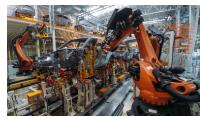 Add My Company
Add My Company
Sign In

In today’s fast-paced business world, manufacturing companies are constantly seeking ways to improve their operations and stay ahead of the competition. One way to achieve this is through the implementation of robotic assembly lines.
In this blog post, we will explore the benefits of robotic assembly lines for manufacturing operations, including increased speed and efficiency, consistent quality and accuracy, reduced labour costs and improved safety, as well as flexibility and adaptability. We will also examine the challenges of implementing robotic assembly lines and the future of this technology.
Advantages of Robotic Assembly Lines
One of the key advantages of robotic assembly lines is increased speed and efficiency. Robots can work at a much faster pace than humans, without the need for breaks or rest, resulting in higher throughput and faster cycle times.
Additionally, robots can operate 24/7, allowing for continuous production without downtime. Consistent quality and accuracy is another benefit of robotic assembly lines. Robots can perform tasks with extreme precision and consistency, reducing the risk of errors and defects. This leads to improved product quality and increased customer satisfaction.
Reduced labour costs and improved safety are additional benefits of robotic assembly lines. Robots can perform dangerous and physically demanding tasks, reducing the risk of injury to human workers. This not only improves safety but also reduces the cost of workers’ compensation claims.
Robots can also be programmed to perform repetitive tasks, freeing up human workers to focus on more complex and value-adding tasks. This results in reduced labour costs and increased productivity.
Challenges of Implementing Robotic Assembly Lines
While the benefits of robotic assembly lines are clear, there are also challenges to implementing this technology. One of the main challenges is the initial investment and operational costs. Robotic assembly lines require a significant investment in capital, which may not be feasible for smaller businesses.
Additionally, integration with existing processes and equipment can be complex, requiring significant planning and coordination.
Finally, training and re-skilling workers to work alongside robots can be a challenge, as workers may be resistant to change and may require additional training to become proficient in working with robotic systems.
Future of Robotic Assembly Lines
The future of robotic assembly lines is bright, with advancements in technology and capabilities driving their increased adoption across various industries. Robotic assembly lines are becoming more intelligent and capable, with the integration of artificial intelligence and machine learning technologies. They are also becoming more modular and customizable, allowing for quick and efficient reconfiguration to meet changing needs. The potential impact of robotic assembly lines on the workforce and employment is also a topic of discussion, with some predicting significant job displacement while others see it as an opportunity to upskill and reskill the workforce.
Conclusion
Robotic assembly lines are a game-changer for industrial automation, offering increased productivity, efficiency, and safety. They are designed to work alongside humans in a shared workspace, and their ease of programming and use make them an attractive option for various industries.
While there are challenges to implementing robotic assembly lines, the benefits they offer make them a worthwhile investment for companies. The future of robotic assembly lines is exciting, with advancements in technology and capabilities driving their adoption across various industries.
Robotic assembly lines are here to stay, and their impact on the future of work and society is something to watch.
For more information on The Benefits of Robotic Assembly Lines for Manufacturing Operations talk to Robot System Products
Enquire Now
List your company on FindTheNeedle.
